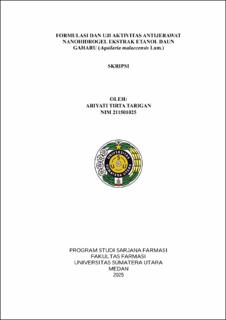Formulasi dan Uji Aktivitas Antijerawat Nanohidrogel Ekstrak Etanol Daun Gaharu (Aquilaria malaccensis Lam.)
Formulation and Anti-Acne Activity Test Nanohydrogel Ethanol Extract of Agarwood Leaves (Aquilaria malaccensis Lam.)

Date
2025Author
Tarigan, Ariyati Tirta
Advisor(s)
Hanum, Tengku Ismanelly
Metadata
Show full item recordAbstract
Background: Acne is an inflammation that occurs due to excess oil production, clogged skin pores, and acne-triggering bacteria. Agarwood leaves (Aquilaria malaccensis Lam.) contain flavonoid and tannin secondary metabolite compounds that have potential as antibacterials so that they can be used to reduce acne on facial skin. Nanohydrogel is a preparation that has the potential to increase the
effectiveness of active substances as anti-acne. Objective: This study aims to formulate a nanohydrogel preparation of ethanol
extract of agarwood leaves and test the antibacterial activity against
Propionibacterium acnes and anti acne of nanohydrogel preparations using ethanol extract of agarwood leaves (Aquilaria malaccensis Lam.) against volunteers. Methods: The ethanol extract of agarwood leaves was prepared by maceration method, then the extract was made into nanoparticles. Antibacterial activity test against Propionibacterium acnes. Nanohydrogel preparations formulated are F1 (2%), F2 (4%) and F3 (6%). Evaluation of nanohydrogels in the form of particle size test, organoleptic, homogeneity, pH, viscosity, spreadability, cycling test, stability at room temperature for 12 weeks, irritation test and antibacterial activity test. Anti-acne activity test on volunteers using a skin analyzer by comparing the
state of facial skin before and after 4 weeks of use of the preparation used 2 times a day with the parameters of sebum levels and the number of acne. Results: The nanoparticle concentration of ethanol extract of agarwood leaves that produces an effective inhibition diameter is 20 mg/ml, which is 11.13 ± 0.66 mm. Nanohydrogel preparations meet the evaluation requirements, stability during 12 weeks of storage, cycling tests, and do not cause skin irritation. The results of the antibacterial activity test of nanohydrogel preparations F1 (2%), F2 (4%), and F3 (6%) have inhibition zones of 13.73 ± 0.15 mm, 14.73 ± 0.15 mm, 15.63 ± 0.21 mm, respectively. The results of the anti-acne activity test on the F3 (6%) nanohydrogel preparation showed a percent decrease in oil content of 33.95% and a percent decrease in the number of acne by 53.77%.Conclusion: Nanohydrogel preparation F3 (6%) showed the most effective antibacterial activity against Propionibacterium acnes bacteria and can be used as anti-acne against volunteers.
Collections
- Undergraduate Theses [1834]
